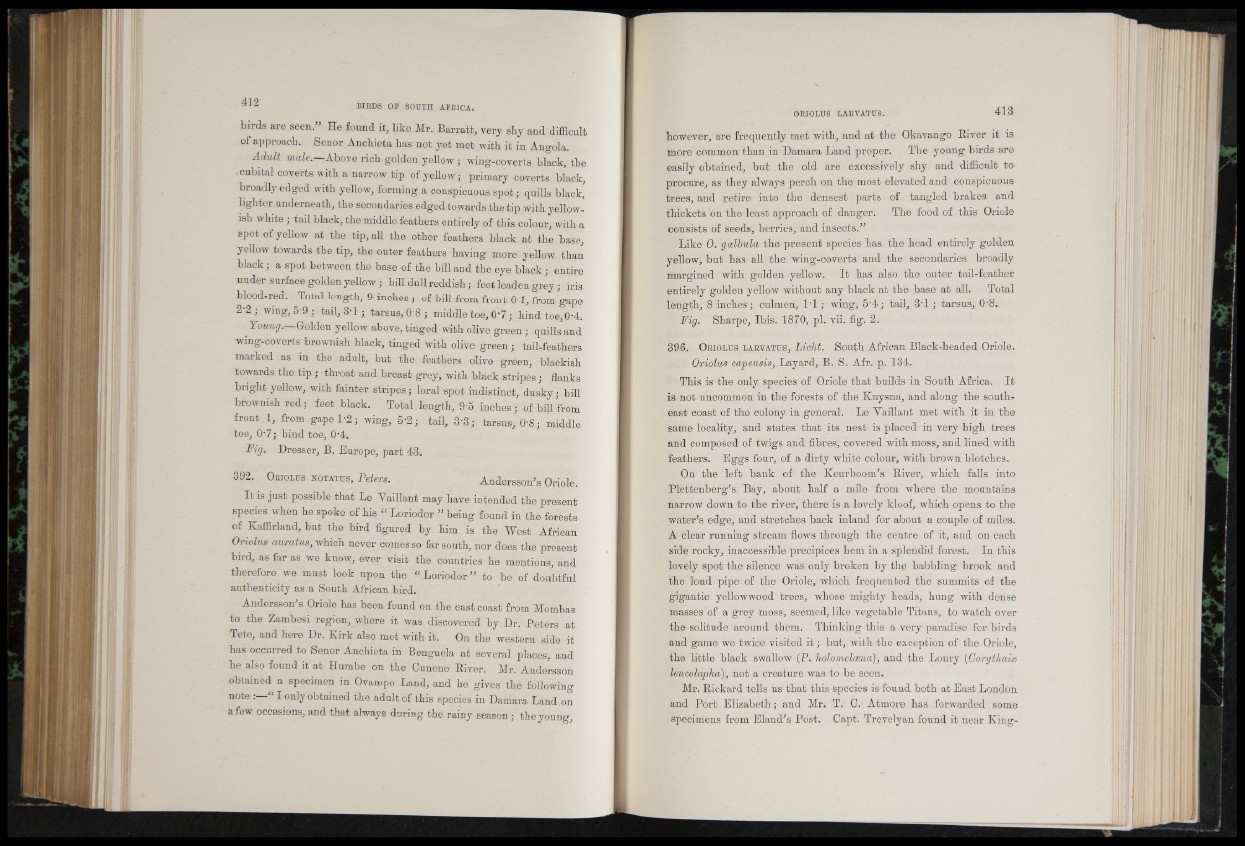
birds are seen.” He found it, like Mr. Barratt, very sky and difficult
of approach. Senor Anchieta has not yet met with it in Angola.
Adult male.—Above rich golden yellow; wing-coverts black, the
-cubital coverts with a narrow tip of yellow; primary coverts black,
broadly edged with yellow, forming a conspicuous spot; quills black,
lighter underneath, the secondaries edged towards the tip with yellowish
white ; tail black, the middle feathers entirely of this colour, with a
spot of yellow at the tip, all the other feathers black at the base,
yellow towards the tip, the outer feathers having more yellow than
black; a spot between the base of the bill and the eye black| entire
under surface golden yellow; bill dull reddish; feet leaden grey; iris
blood-red. Total length, 9 inches; of bill from front OT, from gape
2-2; wing, 5-9; tail, 3T ; tarsus, 0 8 ; middle toe, 0‘7; hind toe, 0-4.
Young. Golden yellow above, tinged with olive green; quills and
wing-coverts brownish black, tinged with olive green; tail-feathers
marked as m the adult, but the feathers olive green, blackish
towards the tip ; throat and breast grey, with black stripes; flanks
bright yellow, with fainter stripes; loral spot indistinct, dusky; bill
brownish red; feet black. Total length, 9 5 inches; of bill from
front 1, from gape 1‘2; wing, 5*2; tail, 3 3; tarsus, 0 8 ; middle
toe, 0‘7; hind toe, 0'4.
Fig. Dresser, B, Europe, part 43.
392. O r i o l u s n o t a t u s , Feters. Andersson’s Oriole.
It is just possible that Le Vaillant may have intended the present
species when he spoke of his “ Loriodor I being found in the forests
of Kaffirland, but the bird figured by him is the West African
Oriolus auratus, which never comes so far south, nor does the present
bird, as far as we know, ever visit the countries he mentions, and
therefore we must look upon the “ Loriodor ” to be of doubtful
authenticity as a South African bird.
Andersson’s Oriole has been found on the east coast from Mombas
to the Zambesi region, where it was discovered by Dr. Peters at
Tete, and here Dr. Kirk also met with it. On the western side it
has occurred to Senor Anchieta in Benguela at several places, and
he also found it at Humbe on the Cunene River. Mr. Andersson
obtained a specimen in Ovampo Land, and he gives the following
note : “ I only obtained the adult of this species in Damara Land on
a few occasions, and that always during the rainy season; the young.
however, are frequently met with, and at the Okavango River it is
more common than in Damara Land proper. The young birds are
easily obtained, but the old are excessively shy and difficult to
procure, as they always perch on the most elevated and conspicuous
trees, and retire into the densest parts of tangled brakes and
thickets on the least approach of danger. The food of this Oriole
consists of seeds, berries,’ and insects.”
Like 0. galbula the present species has the head entirely golden
yellow, but has all the wing-coverts and the secondaries broadly
margined with golden yellow. It has also the outer tail-feather
entirely golden yellow without any black at the base at all. Total
length, 8 inches; culmen, IT ; wing, 5-4; tail, 3T ; tarsus, 0'8.
Fig. Sharpe, Ibis. 1870, pi. vii. fig. 2.
396. O r i o l u s l a r v a t u s , Licht. South African Black-headed Oriole.
Oriolus ca.pensis, Layard, B. S. Afr. p. 134.
This is the only species of Oriole that builds in South Africa. It
is not uncommon in the forests of the Knysna, and along the southeast
coast of the colony in general. Le Yaillant met with it in the
same locality, and states that its nest is placed in very high trees
and composed of twigs and fibres; covered with moss, and lined with
feathers. Eggs four, of a dirty white colour, with brown blotches.
On the left bank of the Keurboom’s River, which falls into
Plettenberg’s Bay, about half a mile from where the mountains
narrow down to the river, there is a lovely kloof, which opens to the
water’s edge, and stretches back inland for about a couple of miles.
A clear running stream flows through the centre of it, and on each
side rocky, inaccessible precipices hem in a splendid forest. In this
lovely spot the silence was only broken by the babbling brook and
the loud pipe of the Oriole, which frequented the summits of the
gigantic yellowwood trees, whose mighty heads, hung with dense
masses of a grey moss, seemed, like vegetable Titans, to watch over
the solitude around them. Thinking this a very paradise for birds
and game we twice visited i t ; but, with the exception of the Oriole,
the little black swallow (P. holomeloena), and the Loury (Corythaix
leucolopha), not a creature was to be seen.
Mr. Rickard tells us that this species is found both at East London
and Port Elizabeth; and Mr. T. 0. Atmore has forwarded some
specimens from Eland’s Post. Oapt. Trevelyan found it near King